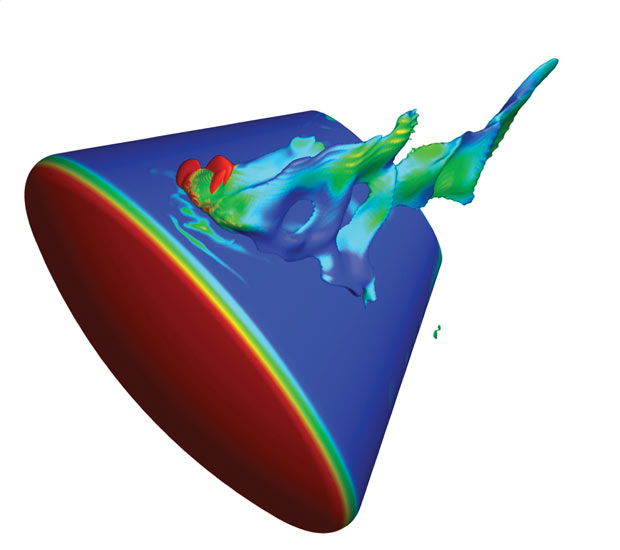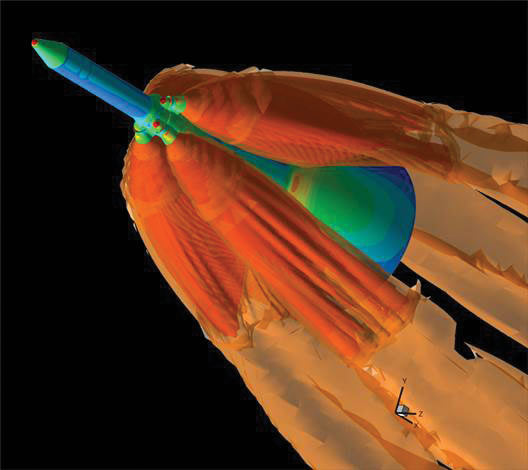
Simulation of roll jets interacting with the incoming flow using DPLR with a SST turbulence model. Image courtesy of Tecplot.
Latest News
December 1, 2015
America’s commitment to deep-space exploration has been reignited. On December 5, 2014, at the Kennedy Space Center in Florida, NASA conducted the first test flight of the Orion Program, launching a new chapter in human space travel. If all goes according to plan, the Orion spacecraft will put humans on an asteroid by 2025 and on Mars in the 2030s.
Unmanned for its first test flight, which lasted just under 4.5 hours, Orion was designed and constructed to travel farther into space than any other spacecraft intended to carry humans and through temperatures twice as hot as molten lava. The sole purpose of the flight was to test Orion’s critical systems under real flight conditions.
 NASA utilized Tecplot tools to run a CFD analysis on Orion’s heat shield before conducting its first unmanned test flight. Image courtesy of Tecplot.
NASA utilized Tecplot tools to run a CFD analysis on Orion’s heat shield before conducting its first unmanned test flight. Image courtesy of Tecplot.More than 1,000 onboard sensors recorded every detail of the flight, from launch to flying in space to re-entry and landing. Flight tests are difficult, complex and nerve-racking, but, if all goes well, they give NASA confidence that the systems it has designed work properly to and from outer space.
Launched aboard a United Launch Alliance Delta IV Heavy Rocket, Orion circled Earth twice and reached an altitude of 3,600 miles during the test flight, about 15 times higher than the International Space Station. To one day accomplish its ultimate mission—sending humans to Mars and bringing them back safely—Orion must withstand extreme speeds, intense radiation and searing temperatures.
Orion’s Thermal Protection System, commonly referred to as a heat shield, is crucial to mission success. It is a protective blanket built with high-tech fibers and ceramics. The outer layer of the heat shield is designed to burn away as it heats up during re-entry into the atmosphere, thus helping to ensure the survivability of the spacecraft. Although round-trip travel to Mars, some 34 million miles from Earth, is the eventual goal, the first step is to design and build a heat shield that can withstand the return trip from lunar areas a mere 230,000 miles away.
The shield is vital to the success of the mission because getting humans into and home from deep space is dangerous. If Orion makes the return journey from Mars someday, it is expected to enter the atmosphere at about 33,500 miles per hour, heating the protective shield to nearly 5,500ºF. The air around it will be about twice as hot as the surface of the sun.
That much heat puts intense stress on materials, and if the heat shield fails, the entire vehicle can be lost. In 2003, Space Shuttle Columbia disintegrated as some of heat-protective tiles failed just before landing, killing all seven crew members aboard.
 Simulation of roll jets interacting with the incoming flow using DPLR with a SST turbulence model. Image courtesy of Tecplot.
Simulation of roll jets interacting with the incoming flow using DPLR with a SST turbulence model. Image courtesy of Tecplot.To predict temperature and airflow around the heat shield during re-entry, a team of about 20 engineers analyzed heat shield materials in NASA Ames’ Arc Jet wind-tunnel and then compared the results with those generated by CFD (computational fluid dynamics) simulations. They then used Tecplot 360 EX as a post-processor to analyze, visualize and understand the CFD results.
Developed by Bellevue, WA-based Tecplot, Inc., Tecplot 360 EX is CFD (computational fluid dynamics) visualization and analysis software for engineers and scientists. It allows technical professionals using commonplace desktop computers and laptops to quickly analyze and understand information hidden in massive CFD simulation data, and communicate their results to others via images and compelling animations.
The Tecplot software helped engineers at several NASA facilities—including NASA Ames, NASA Langley and NASA Johnson—visualize the simulations generated by two NASA-developed CFD solvers: DPLR, which stands for Data Parallel Line Relaxation; and LAURA, which stands for Langley Aerothermodynamic Upwind Relaxation Algorithm. The DPLR and LAURA tools simulate the physics of the extreme heat generated when an object enters Earth’s atmosphere.
The NASA team ran about 2,000 DPLR and LAURA simulations and analyzed those simulations with Tecplot 360 EX to see how Orion would survive re-entry. The typical file size of these simulations was impressive—1.5 gigabytes for a DPLR solution and .5 gigabytes for a LAURA solution. The simulations tell NASA how hot the heat shield surface will get when entering the atmosphere based on the known physics of friction of the molecules in the atmosphere flowing over the heat shield. The team knows from other testing at what temperature the heat shield will melt, so if the simulations show the temperature staying below that mark, then they can safely predict that Orion will survive that part of the re-entry process.
Orion’s descent from its first test flight was precise and predictable, but pulse-pounding nonetheless. At about 75 miles above Earth, the craft re-entered the planet’s atmosphere, traveling more than 20,000 mph. During re-entry, the air particles forced out of its way heat up, creating an envelope of hot plasma that surrounded the craft as it plummeted towards Earth. The plasma reached temperatures of 4,000 ºF, making it the most dangerous part of the test flight.
Mission Control monitored all the data from the spacecraft, but no data could penetrate the plasma for several minutes. Once communication was re-established, onboard systems ignited jets to keep the ship pointed correctly – bottom down – so the specially constructed and thoroughly tested heat shield could take the full brunt of the inferno.
The craft eventually slowed as the atmosphere thickened from 20,000 mph to about 300 mph, but it had to slow down even more to land safely in the Pacific Ocean, just off the California coast. Specially designed parachutes helped Orion “hit the brakes,” but not too quickly. One day, people will be onboard, so deceleration must happen in stages for the comfort and safety of the crew.
When the first two parachutes deployed, Orion slowed to 175 miles per hour. At this point, the three main parachutes opened. Once fully deployed, the umbrella of parachutes would cover an entire football field. Eventually, descent slowed to 20 mph and then splash down.
After the spacecraft, and the invaluable test-flight data housed within its delicate sensors, was recovered with the help of U.S. Navy ships, the NASA team went back to work evaluating how well their predictions stacked up against the harsh realities of space. They should have plenty of time to study the results and make any necessary adjustments – the next unmanned test flight of Orion is not expected until late 2017 or early 2018.
More Info
Subscribe to our FREE magazine, FREE email newsletters or both!
Latest News
About the Author
DE’s editors contribute news and new product announcements to Digital Engineering.
Press releases may be sent to them via [email protected].






